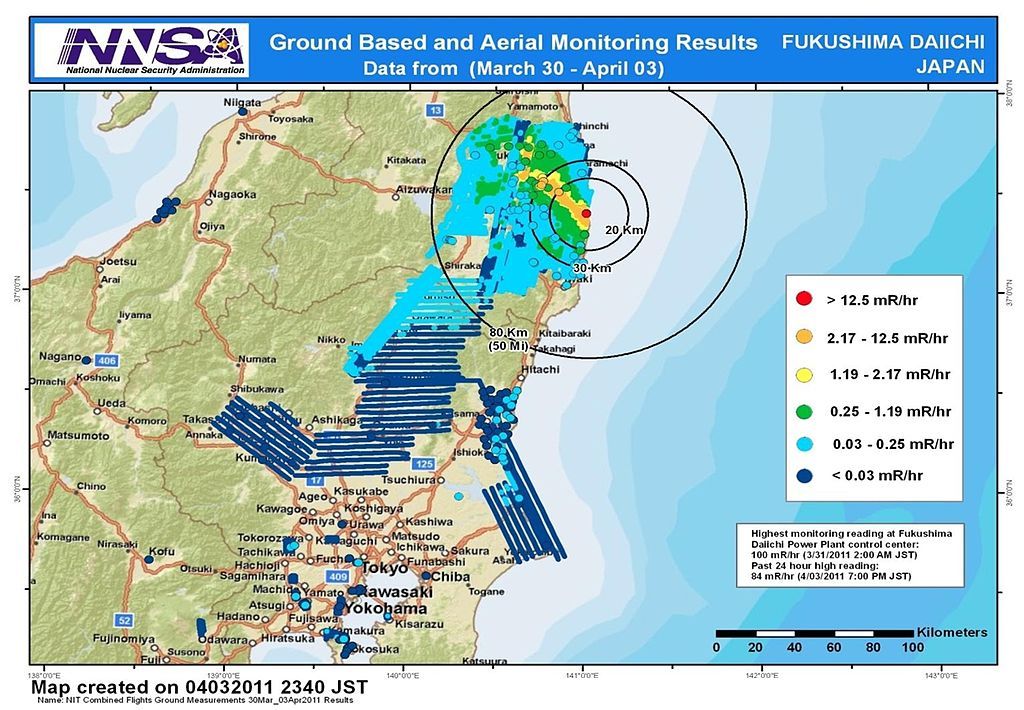The Fukushima accident: Do we have the wisdom to move forward?
By Allison Macfarlane | March 11, 2021
 Combined results of 211 flight hours of aerial monitoring operations and ground measurements in the Fukushima area made by the US Energy Department, US Defense Department, and Japanese monitoring teams from March 30, 2011 to April 3, 2011. Source: National Nuclear Security Administration (NNSA)/ US Energy Department
Combined results of 211 flight hours of aerial monitoring operations and ground measurements in the Fukushima area made by the US Energy Department, US Defense Department, and Japanese monitoring teams from March 30, 2011 to April 3, 2011. Source: National Nuclear Security Administration (NNSA)/ US Energy Department
Editor’s note: This article is part of a collection of expert commentary on nuclear safety published on the tenth anniversary of the Fukushima disaster, produced in a collaboration between the Project on Managing the Atom at Harvard Kennedy School and the Bulletin.
The 10th anniversary of the Fukushima accident gives us a chance to reflect on the response to possible future accidents in the context of the continued use of nuclear power.
I am not making a case for or against nuclear energy here. I am sharing the benefit of my experience as a nuclear regulator. Nuclear power is not free of risk—obviously. But these risks must be weighed against risks in the larger energy context. And possible accidents at nuclear reactors must be measured against the coming calamity of climate change brought on by our reliance on fossil fuels.
The Fukushima accident has taught us how to reconceive some of these risks. First, the number of dead people is not the only relevant metric for a nuclear power accident. Nuclear power advocates claim that the Fukushima accident did not kill anyone directly, with the implication that the accident wasn’t that bad. But it was. Many people lost property, land, jobs, and community. Over 160,000 people evacuated, but fewer than 35 percent of them have returned. The fishing industry remains devastated. Agricultural industry is just beginning to come back. The cost for Fukushima decommissioning, decontamination, and compensation will be at least $188 billion and up to $736 billion. And that doesn’t count the loss of the 24 reactors permanently shut down, the updates to existing reactors, and the costs to replace the electricity lost.
One risk-reduction measure involves the periodic updating of nuclear power plant regulations relating to natural hazards, like earthquakes and flooding, based on advances in scientific understanding of these phenomena. Many US reactors were sited when the basic paradigm of plate tectonics was just being accepted. Our understanding of seismic hazard has advanced significantly over the last 40 years. Similarly, we know that climate is changing and with it, flooding risks. The US Nuclear Regulatory Commission was in the process of requiring updates relating to natural hazards as a result of the Fukushima accident when the three Republican members of the Commission voted down that effort two years ago. It was a lesson unlearned, in that case.
Moving forward with nuclear power should require us to finally deal with the full fuel cycle and have a functional plan in place to dispose of nuclear waste. The spent fuel in the fuel pool at the unit 4 reactor at Fukushima, which was almost full, came perilously close to being uncovered as water evaporated when plant operators finally were able to add water. If the fuel had become uncovered, some estimates suggested that the resulting fire could have spread radiation as far as Tokyo. In future, we need to ensure that spent fuel pools aren’t maintained in full condition, and that spent fuel has a clear path to disposal.
Sometimes there are straightforward solutions that aren’t always followed. After the Three Mile Island, Chernobyl, and Fukushima accidents, many countries required the addition of simple systems that filter radioactive gases released in the event of a core melt, rather than releasing them directly to the environment. The US, in fact, is one of the few countries that chose not to add filters to containment vents. Again, the majority of commissioners overruled the NRC staff, which had recommended doing so. Another lesson not learned.
Finally, and perhaps most important, is the need for an independent regulator, free from industry and political influence, with strong government backing, adequate financial and human resources, and the ability to shut down unsafe plants. All countries that have nuclear regulators grapple with independence. If nuclear power plants are to play a role in the transition away from a climate-destroying carbon economy it is essential that we ensure the regulator is able to make nuclear power as safe as it can be.
Read more expert commentaries in this collection »
Together, we make the world safer.
The Bulletin elevates expert voices above the noise. But as an independent nonprofit organization, our operations depend on the support of readers like you. Help us continue to deliver quality journalism that holds leaders accountable. Your support of our work at any level is important. In return, we promise our coverage will be understandable, influential, vigilant, solution-oriented, and fair-minded. Together we can make a difference.
Keywords: Fukushima accident, fukushima10, independent nuclear regulator, spent fuel pool, vents
Topics: Nuclear Energy, Nuclear Risk
















Lessons have not been learned. The NRC is a captured agency. North Anna NPP was the first USA reactors to have been knocked off line by an earthquake and the 5.8 exceeded the plants design, just 5 months after Fukushima’s nuclear catastrophe. Yet, here we are years later and the NRC is going to allow Dominion a license extension to run up to 80 years., with no new environmental impact review and no required upgrades. Had North Anna 3 been built, it was going to be built at a higher seismic standard and even moved to a different location on… Read more »